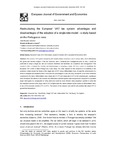Mostrar o rexistro simple do ítem
Restructuring the European VAT tax system: advantages and disadvantages of the adoption of a single-rate model - a study based on the Portuguese case
| dc.contributor.author | Catarino, João Ricardo | |
| dc.contributor.author | Moraes e Soares, Ricardo | |
| dc.date.accessioned | 2019-12-26T12:26:32Z | |
| dc.date.available | 2019-12-26T12:26:32Z | |
| dc.date.issued | 2019 | |
| dc.identifier.citation | Catarino, J., & Moraes e Soares, R. (2019). Restructuring the European VAT tax system: advantages and disadvantages of the adoption of a single-rate model - a study based on the Portuguese case. European Journal of Government and Economics, 8(2), 145-160. https://doi.org/10.17979/ejge.2019.8.2.5478 | es_ES |
| dc.identifier.issn | 2254-7088 | |
| dc.identifier.uri | http://hdl.handle.net/2183/24547 | |
| dc.description.abstract | [Abstract] The common VAT system adopted by EU member states comprises a set of various rates, which differentiate the goods and services subject to this tax. However, from a technical and management point of view, it would be preferable to adopt a single tax rate as it reduces distortions and facilitates tax compliance and management. This research seeks to analyse the benefits and disadvantages of adopting a single VAT as a means of simplifying the European VAT model. It takes Portugal as a case study. The main objective of this research is to contribute to the academic debate around the theme of the single rate of VAT versus differentiated rates, through the achievement of a series of analyses and statistical tests to revenues and percentages of GDP that they correspond, in the three scenarios considered in the study: differentiated rates, single rate of 17% and single rate of 21%.In the empirical part, hypotheses were developed, the effects on tax revenue of a differential collection system were analyzed and compared to a possible single rate regime on consumption to verify which one would be more efficient. data comparison permits to verify that the estimated revenue of the single rate of VAT is higher than the values obtained by the system of differentiated rates, in any of the proposed models (17% or 21%). The results of this research are valid for all countries that adopt VAT or general tax transactions. | es_ES |
| dc.language.iso | spa | es_ES |
| dc.publisher | Universidade da Coruña, Servizo de Publicacións | es_ES |
| dc.relation.uri | https://doi.org/10.17979/ejge.2019.8.2.5478 | es_ES |
| dc.rights | Atribución-NoComercial 4.0 España | es_ES |
| dc.rights.uri | http://creativecommons.org/licenses/by-nc/3.0/es/ | * |
| dc.subject | Consumer tax | es_ES |
| dc.subject | Fiscal policy | es_ES |
| dc.subject | Single VAT rate | es_ES |
| dc.subject | Value-added Tax | es_ES |
| dc.subject | Tax equity | es_ES |
| dc.subject | Tax system | es_ES |
| dc.title | Restructuring the European VAT tax system: advantages and disadvantages of the adoption of a single-rate model - a study based on the Portuguese case | es_ES |
| dc.type | info:eu-repo/semantics/article | es_ES |
| dc.rights.access | info:eu-repo/semantics/openAccess | es_ES |
| UDC.journalTitle | European Journal of Government and Economics | es_ES |
| UDC.volume | 8 | es_ES |
| UDC.issue | 2 | es_ES |
| UDC.startPage | 145 | es_ES |
| UDC.endPage | 160 | es_ES |






